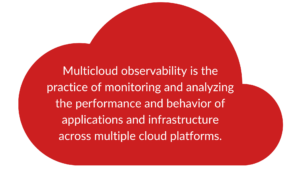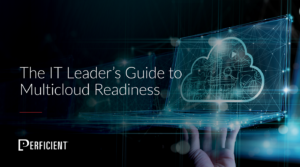As businesses increasingly adopt multicloud architectures to drive innovation and create value, IT leaders face the challenge of ensuring observability across different cloud platforms. In the ‘IT Leader’s Guide to Multicloud Readiness,’ we discussed the importance of adopting a multicloud strategy and offered tips for identifying the right cloud providers and services, optimizing costs, and maintaining critical app and service reliability in a multicloud environment.
Multicloud observability is the practice of monitoring and analyzing the performance and behavior of applications and infrastructure across multiple cloud platforms, such as Amazon Web Services (AWS), Microsoft Azure, and Google Cloud Platform (GCP). Businesses today are increasingly adopting multicloud architectures to drive innovation and create value, which can lead to an increase in system complexity and fragmentation. Multicloud observability helps IT leaders ensure that their critical applications and services are reliable, secure, and performing well in a multicloud environment. By having visibility into their entire cloud infrastructure, IT leaders can quickly identify and address issues, optimize costs, and improve overall business operations.
In this blog post, we’ll explore how multicloud observability can help businesses achieve their goals and offer some additional tips and best practices for IT leaders to consider when implementing observability in their organization.
MULTICLOUD OBSERVABILITY DURING MIGRATION
When migrating to the cloud, businesses may encounter several challenges that can impede the smooth functioning of their operations. These challenges include a temporary increase in system complexity and fragmentation, different cloud providers with their own unique monitoring and logging tools that may not be compatible with each other, and time-consuming installation and configuration of monitoring agents on each cloud platform. However, with multicloud observability, these challenges can be mitigated effectively.
One way to encounter these challenges is when moving workloads from one public cloud platform to another, such as from Amazon Web Services (AWS) to the Google Cloud Platform (GCP). In such scenarios, cloud observability can become a challenge, especially when businesses consider investing in third-party observability tools that provide a single-plane-of-glass view across different cloud platforms. While this option may be viable for some businesses, it may not be feasible for all due to various reasons.
Thankfully, the Google Cloud Operations Suite (formerly Stackdriver) offers a seamless solution for monitoring, logging, and tracing across GCP and AWS. Using GCP Operations Suite, businesses can effectively monitor their servers (EC2 instances) on AWS during the migration process or in a typical multicloud scenario where their workloads are distributed between AWS and GCP, ensuring a smooth and uninterrupted cloud experience.
TIPS FOR IMPLEMENTING MULTICLOUD OBSERVABILITY
How can IT leaders implement multicloud observability in their organization? Here are some tips and best practices to consider:
- Define Your Observability Needs: Start by defining your business goals and what kind of observability you need to achieve them. This may involve identifying key metrics and data points to monitor, as well as any compliance or regulatory requirements.
- Choose the Right Tools: Evaluate different observability tools and services based on your needs, budget, and technical requirements. Consider factors such as scalability, ease of use, and integration with your existing infrastructure.
- Implement Monitoring Agents: Once you’ve chosen your observability tools, implement monitoring agents on your cloud instances to collect logging data and metrics. In the case of GCP Operations Suite, install the Monitoring and Logging agents on your AWS EC2 instances to send data to your GCP project.
- Visualize and Analyze Data: Use the data collected by your observability tools to create visualizations.
NEXT STEPS
Multicloud observability is a critical aspect of any multicloud strategy, and Google Cloud Operations Suite can help IT leaders effectively monitor their workloads across multiple cloud platforms. By leveraging this tool, organizations can ensure seamless logging, monitoring, and tracing across AWS, GCP, and other common applications. If you’re interested in learning more about multicloud readiness and want to dive deeper into these aspects and more, be sure to download the ‘IT Leader’s Guide to Multicloud Readiness.‘ This practical guide provides valuable insights and important factors to consider when developing your multicloud strategy, as well as tips for identifying the right cloud providers and services, optimizing costs, streamlining workload deployment and management, and maintaining critical app and service reliability in a multicloud environment.


Your article on achieving multicloud observability succinctly captures the essence of managing complex cloud environments. The importance of real-time visibility across multiple clouds cannot be overstated. It’s the key to detecting issues, optimizing performance, and ensuring a seamless user experience. Your insights are spot-on, and I appreciate the clarity of your explanations. Monitoring, analyzing, and acting upon data from different clouds is indeed a formidable challenge, and your article sheds light on essential strategies for success. Well done!